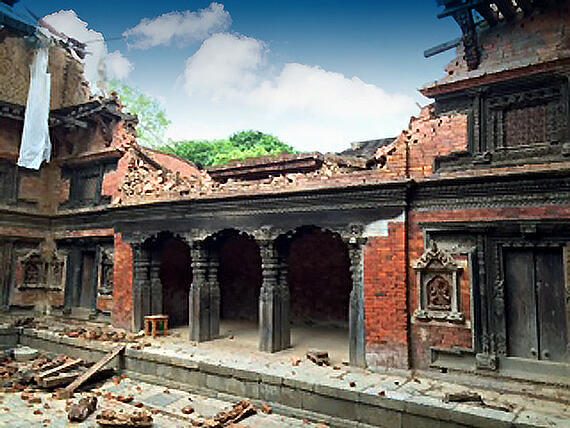Update from Kathmandu Valley Preservation Trust on Patan Royal Palace Complex after Nepal Earthquake in April

Since 1991, Kathmandu Valley Preservation Trust (KVPT), based in New York City, has restored and preserved Nepal's magnificent cultural architectural treasures for Nepali's and the international community. WMF has worked with KVPT over the last ten years to produce a multiphase preservation plan for the Patan Royal Palace Complex. In light of the devastating earthquake in Nepal on April 25, WMF wanted to share this update about the palace from Erich Theophile and Susannah Robinson of KVPT.
World Monuments Fund has been a generous donor to KVPT for the past ten years, and we have always felt WMF to be wonderful professional partners to work with, with an instinctive sense of what is needed in the complex area of cultural preservation in the developing world—because this is their area of expertise too.
Prior to the devastating earthquake in Nepal on April 25, the KVPT was close to completion of our ten year campaign to restore and protect the Patan Royal Palace Complex, one of the jewels of Nepali/Newar architecture. In fact, this wonderful complex had just been opened to the public for the first time in its history and we were rejoicing in that.
In the days since the earthquake, the architectural preservation work we do has emerged as more critical than ever, and KVPT is uniquely positioned to meet the new challenges facing Nepal.
We wanted to give you a specific update on what we know to date of the Patan Palace Complex projects. What KVPT achieved with WMF’s long term help—the buildings and monuments restored—withstood the test of the earthquake better than we could have expected given its great intensity and how close it was to the surface. Without the grants and money from the Robert W. Wilson Challenge funds WMF provided to KVPT, so much more would have been lost.
Concerned as we all are with the scale of the humanitarian crisis in Nepal, now must also be the time to plan for the future, ensuring the protection of the cultural treasures critical to Nepal's revenues and national pride. KVPT is asking all our friends and past partners to start support for the restoration and damage assessment for the temples of Kathmandu and Patan. This architectural heritage is culturally and spiritually important, but also economically for tourism that brings much needed revenue to Nepal.
As you have seen from the media, alongside the human losses, the devastating loss of Nepal's cultural heritage is in fact being mentioned over and over by Nepalis as one of the most shocking impacts of the earthquake. KVPT is uniquely positioned to help.
The first miracle was that KVPT staff and their families are safe—some lost their homes and their possessions—but they are safe and KVPT will ensure that their lives will be put back in place.
There is some wonderful, inspiring news in the midst of all the loss. KVPT’s Nepal Program Director Rohit Ranjitkar reported that during a government inspection of the Patan Palace, our current and largest endeavor, people were speechless coming in to see “not a tile was out of place” in the main areas of the new Patan Museum architectural galleries. From these inspections, we can also report that among the KVPT’s 45 restored building projects in Kathmandu and Patan, there were only three examples of major structural damage and some minor damage incidents.
Specifically, the damaged structures include the Radha Krishna Temple, Patan (restored 1992) and the Shiva and Kageshwar Temples, Kathmandu Darbar Square (restored in 2000). All of these can be re-built and restored. At the Patan Palace, the glorious Sundari Chowk courtyard building, still inaccessible, appears to have no damage except for the rear wing, still a partial ruin from 1934, which was waiting for funding to be rebuilt this fall. We will report more on conditions as sites become accessible.
It should be noted that many of our projects have incorporated a variety of types and levels of seismic strengthening measures, so there will be many important lessons to share as repair and rebuilding efforts move forward. We are in touch with Robert Silman Associates, the New York-based engineers that we worked with in 1999-2000 on the Kathmandu Darbar Initiative and more recently on seismic reinforcements at the Patan Darbar.
Post-earthquake, governments and international organizations are identifying KVPT as a significant player in repair efforts based on our expertise and track record. We are being cited for our abilities to work with local groups and in local conditions to achieve the finest international standards of restoration. But this next stage is going to be costly and require new funding and more people on the ground. The work ahead is as immense as the need for new and renewed funding support.
We look forward to working with World Monuments Fund in the coming months and thank you again for your support of the past years. Visit http://www.kvptnepal.org/ for more information.
